

The Differentiator. Try Respondo!
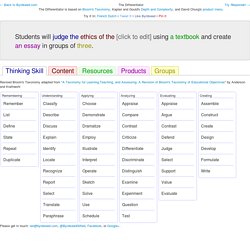
→ ← Back to Byrdseed.com The Differentiator. Huntington School Teaching & Learning. It is a commonly used term, but do we actually really agree what DIFFERENTIATION mean?
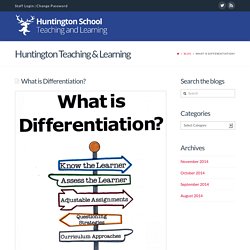
In the training session I described the following points: Love Learning Ideas.
Assessment for Learning #EduSketchNote – tips4teaching. CPD - Marking and Feedback. Introducing pace and purpose into your lessons. Involving students in assessment conversations. For students to be actively engaged in their own learning journey, they need to know what they are learning, why they are learning it, how to learn it, how well they are learning it, and how to take the next steps to advance their learning.

These are the skills of lifelong learners that can positively contribute to their performance now and into the future. This process however is more easily said than done. Understanding some of the factors involved in supporting students to develop these skills is a start. Adie and Willis have been working alongside teachers over the past three years analysing how they develop a common understanding of the standard required for a year level (Adie & Willis, 2013), and how they share this understanding with their students (Willis & Adie, 2014). It is important for teachers to develop a shared understanding of the standard from the start of teaching a specific year level cohort as this influences how they teach and work with their students.
7 Things To Remember About Classroom Feedback. 10 Assessments You Can Perform In 90 Seconds. Good assessment is frequent assessment.
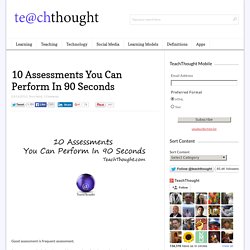
Any assessment is designed to provide a snapshot of student understand—the more snapshots, the more complete the full picture of knowledge. On its best day, an assessment will be 100% effective, telling you exactly what a student understands. More commonly, the return will be significantly lower as the wording of questions, the student’s sense of self-efficacy, or other factors diminish their assessment performance. It sounds obvious, but a student is a human being with an entire universe of personal problems, distraction, and related challenges in recalling the information in the form the assessment demands. Feedback: let’s build it in, not add it on.
Image: @jasonramasami The quantity of feedback our students need after completing a task is largely dictated by the quality of teaching they have received before and during this task.
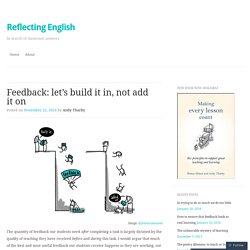
Marking – Effective, Developmental & Time-Saving. Finally, in a time of what appears to feel like the ‘shackles’ are starting to come off in terms of a less OFSTED driven, prescriptive evaluation for teachers across the country, it seems that creativity, innovation and risk-taking are all starting to blossom in schools.
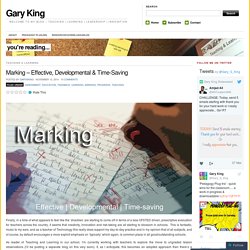
Target Setting and Measuring Progress. 20 Ways To Provide Effective Feedback For Learning. 20 Ways To Provide Effective Feedback For Learning by Laura Reynolds While assessment gets all the press, it is feedback for learning that can transform a student’s learning.
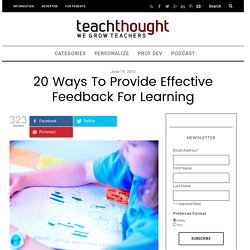
When feedback is predominately negative, studies have shown that it can discourage student effort and achievement (Hattie & Timperley, 2007, Dinham). Like my experience, the only thing I knew is that I hated public speaking and I would do anything possible to get out of it. As a teacher, most of the time it is easy to give encouraging, positive feedback. Approaches to Marking. This series of #backtoschool blogs summarises much of my thinking as it’s developed over the past few years and is aimed at new or recently qualified teachers.

Each area has been distilled to 5 ‘top tips’ which I hope prove useful to anyone embarking on a career in teaching. Level up Competency 4 by 4. Level up Pre-Assessment 4 by 4. Level up Questioning for proof 4 by 4. Edutopia cochrane schturnaround PD essential questions. The 20%: Questioning. This is Part One of a new 2-part blog exploring effective questioning in the classroom.In a previous post I talked about the Pareto Principle.
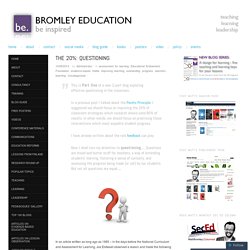
I suggested we should focus on improving the 20% of classroom strategies which research shows yield 80% of results. In other words, we should focus on practising those interventions which most expedite student progress.I have already written about the role feedback can play.Now I shall turn my attention to questioning… Questions are bread-and-butter stuff for teachers, a way of extending students’ learning, fostering a sense of curiosity, and assessing the progress being made (or not) by our students. But not all questions are equal… In an article written as long ago as 1985 – in the days before the National Curriculum and Assessment for Learning, Jos Elstweet observed a lesson and made the following comments: Levels of Questions in Bloom's Taxonomy: Teaching Methodoly Advice (Grades K-12) - TeacherVision.
Challenge your students with all levels of questions as defined by Bloom's Taxonomy.

They will be doing higher-level thinking and you will have a more interesting classroom! New teachers will find this resource particularly valuable. Analysis An analysis question is one that asks a student to break down something into its component parts. To analyze requires students to identify reasons, causes, or motives and reach conclusions or generalizations. 10 Silver Arrows: Ideas to penetrate the armour of ingrained practice. One arrow, aimed at the right place…..that’s all it takes. *Ideas are the currency of the 21st century* Questioning and Feedback: Top Ten Strategies. As part of our whole staff training at Huntington School we have been sharing ideas and collating ‘Top Ten Strategies’. This list is the fruits of our labour: 1. Differentiated questioning. Given the time we take doing it daily, effective questioning may well be the highest impact strategy we can employ.
The Most Followed Teacher on Twitter in the UK.
Student resources. 27 Ways To Inspire Innovative Thinking In Students. 27 Ways To Inspire Innovative Thinking In Students Innovating thinking is one of those awkward concepts in education–one that is often espoused, but isn’t measured, reported on, trained around, or celebrated. It’s just sort of there. Innovative thinking in students will flower when we design classrooms that absolutely can’t survive without it.
Same with critical thinking, self-direction, creativity, and so on. Until we reach that point, it’s on the shoulders of the classroom teacher to tease it out of students through a combination of inspiration, modeling, scaffolding, and creating persistent opportunity. The following graphic by Mia MacMeekin offers 27 ways to think about this idea. On the other hand, “Solve: Solve a simple problem every day,” “Try: Try lots of (new) ways”, “Risk: Take risks”, as well as Change, Challenge, Draw, Share, and Dream all can be simple but effective strategies to force new thinking on to students, or from students.
The Sheridan Center for Teaching and Learning. Students learn through their participation in the attainment of knowledge by gathering information and processing it by solving problems and articulating what they have discovered. Each activity below provides students with opportunities to deepen their learning by applying concepts and articulating new knowledge and many of these activities also provide the instructor feedback about the students’ learning. Entry/Exit Tickets Entry & Exit tickets are short prompts that provide instructors with a quick student diagnostic. These exercises can be collected on 3”x5” cards, small pieces of paper, or online through a survey or course management system.
Entry tickets focus student attention on the day’s topic or ask students to recall background knowledge relevant to the day’s lesson: e.g., “Based on the readings for class today, what is your understanding of ___________?” Learn more about entry and exit tickets, and see examples. Free Writing/Minute Paper/Question of the Day Exercise.